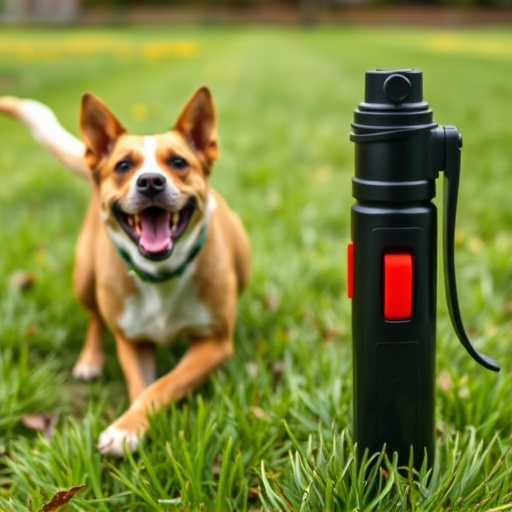In regions where dog spray is governed by specific laws, manufacturers adhere to safety standards and guidelines ensuring user and animal protection. Key safety features in canine repellents like mace dog spray include activation locks, pressure regulators, and non-lethal ingredients. Understanding these features is vital for legal defenses, as they demonstrate reasonable fear and proportional responses to imminent dog attack threats. Emphasizing these safety aspects when facing charges can argue for reasonable use, mitigating criminal liability while documenting context, necessity, training, permits, and expert testimony strengthens the defense further.
In an era where personal safety is paramount, understanding the legalities surrounding dog spray becomes essential. This comprehensive guide delves into “Understanding Dog Spray Legalities,” offering a detailed overview of regulations and protections. Furthermore, we explore “The Role of Safety Features in Canine Repellents,” examining advancements that enhance both effectiveness and responsible use. For those facing legal challenges, “Building a Strong Defense: Strategies for Legal Protection” provides valuable insights and strategies to navigate the complexities, ensuring fair treatment and peace of mind.
- Understanding Dog Spray Legalities: A Comprehensive Overview
- The Role of Safety Features in Canine Repellents
- Building a Strong Defense: Strategies for Legal Protection
Understanding Dog Spray Legalities: A Comprehensive Overview
In many jurisdictions, dog spray, also known as canine repellent, is subject to specific regulations and legal considerations. Understanding the legality of this self-defense tool is crucial for anyone concerned about their safety around dogs. The primary focus often revolves around public safety features implemented in these repellents. Manufacturers are required to adhere to strict guidelines when designing and producing dog sprays, ensuring they are safe for both users and animals. These safety measures include controlling the concentration of active ingredients, implementing user-friendly application mechanisms, and incorporating safeguards to prevent misuse or accidental activation.
Legal defenses centered around dog spray usage typically hinge on demonstrating reasonable fear and proportional response. Users must be able to prove that their use of canine repellent was a rational reaction to an imminent threat posed by a dog. The court will consider factors such as the dog’s behavior, its history of aggression (if any), and the user’s knowledge or awareness of these behaviors before employing the spray. Understanding local laws and regulations is paramount for individuals seeking to legally defend their actions when using dog sprays to protect themselves or others from potential canine attacks.
The Role of Safety Features in Canine Repellents
In the realm of canine repellents, especially those employing spray mechanisms like mace dog spray, safety features play a pivotal role. These safety measures are designed to ensure that both users and animals remain protected during interaction. Key among them is the inclusion of activation locks or safety triggers that prevent accidental discharge, safeguarding handlers from misuse and unexpected exposure. Additionally, canisters equipped with pressure regulators help control spray distribution, minimizing off-target effects and reducing environmental impact.
Furthermore, the use of non-lethal ingredients and formulations tailored for animal deterrence without causing permanent harm underscores the commitment to safety. These features not only promote responsible usage but also underscore the industry’s evolution in addressing concerns related to animal welfare. As users navigate the legal defenses surrounding mace dog spray, understanding these safety features becomes crucial in justifying their necessity and effectiveness.
Building a Strong Defense: Strategies for Legal Protection
In building a strong defense against charges related to the use of dog spray, understanding the legal protections and strategic approaches is key. One effective strategy involves emphasizing the safety features in canine repellent products. These include design elements that ensure minimal harm to both humans and animals, as well as mechanisms for controlling the dispersion and intensity of the spray. By showcasing these safety aspects, legal teams can argue that the use of dog spray was a reasonable and proportionate response to a threat, mitigating potential criminal liability.
Additionally, documenting the context and necessity of using canine repellent is crucial. This includes providing evidence of attempts to de-escalate situations before resorting to spray, as well as proof that the target individual posed an immediate danger. Legal experts recommend keeping detailed records of training, permits (if applicable), and any expert testimony supporting the use of dog spray as a last resort for public safety. These measures collectively strengthen the defense by demonstrating due care and adherence to legal guidelines governing the use of force.
In understanding the legal landscape surrounding dog spray, it’s evident that safety features within canine repellents play a crucial role. By employing strategies outlined in this article—from comprehending regional regulations to leveraging innovative, non-lethal technologies—individuals and professionals can build robust defenses and ensure responsible use, ultimately contributing to safer communities for humans and animals alike. The integration of safety features in canine repellents is not just a trend; it’s a necessary step towards a more balanced and humane approach to conflict resolution.
